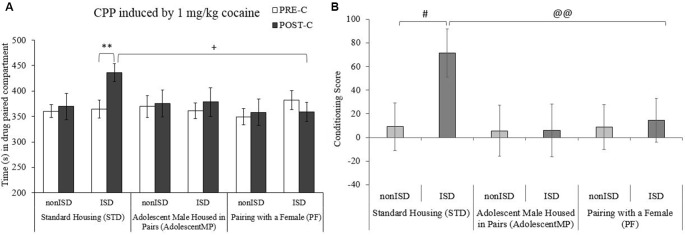Figure 3.
Positive housing conditions decrease the effects of ISD stress on the acquisition of 1 mg/kg cocaine-induced conditioned place preference (CPP). Bars represent the following groups: standard housing (STD-nonISD n = 12; STD-ISD n = 12); male animals housed in pairs since adolescence (AdolescentMP-nonISD n = 12; AdolescentMP-ISD n = 12); male animals paired with a female for long or short term (PF-nonISD = 20, PF-ISD = 20). (A) The bars represent the time (s) spent in the drug-paired compartment in the PRE-C test (before conditioning sessions; white bars), and in the POST-C test (after conditioning sessions; black bars). Data are presented as mean values ± SEM. Bonferroni’s test **p < 0.01 significant difference in the time spent in the drug-paired compartment in POST-C vs. PRE-C in STD-ISD animals. +p < 0.05 significant differences in the POST-C time between STD-ISD vs. PF-ISD. (B) Bars represent the conditioning score (CS), calculated as the time spent in the drug-paired compartment in the Pre-C test minus the time spent there in the Post-C test. #p < 0.05 significant difference between STD-nonISD vs. STD-ISD. @@p < 0.01 significant difference between STD-ISD vs. PF-ISD.

